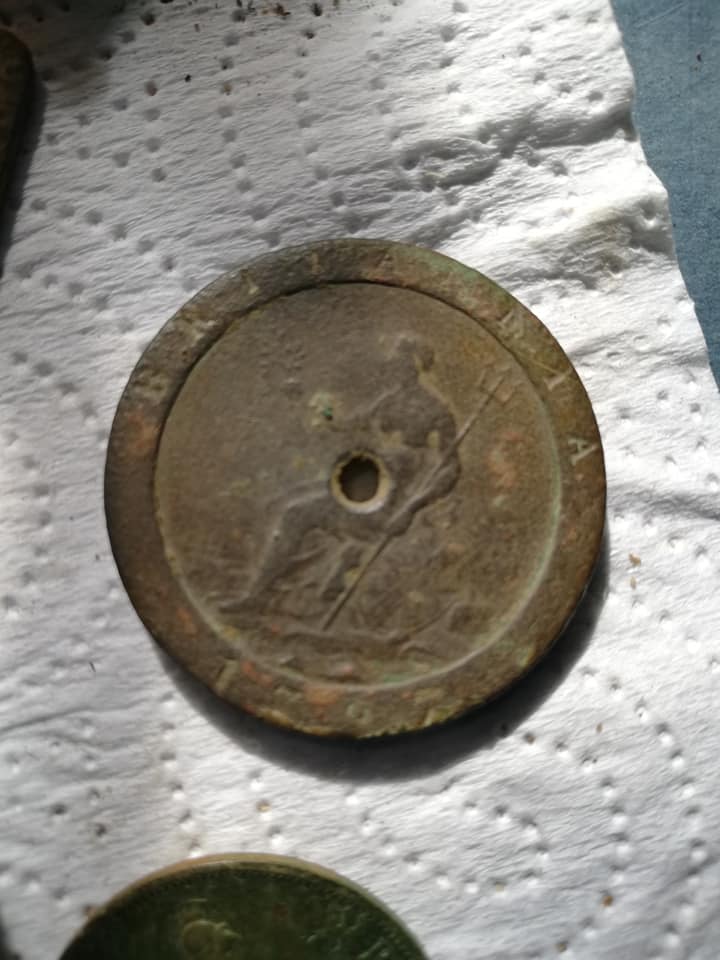On Tuesday, 20 October 2020, I headed to a new site that I’d been researching extensively, for nearly a month. Located in the Southern Highlands of New South Wales, Australia, it had once been a thriving township in the mid-1800s, but is now a sleepy village. I had already been there twice, scouting out the area, attempting to locate the site of what had once been an Inn, but was now public land. I had previously located what was surely the site of an old stables, finding a number of horse buckles and saddlery rivets, as well as a few early 1900s pre-decimal coins.
It was a cool and overcast day, as I parked my car and entered the site. I headed straight for an area I’d identified as looking promising on Google Earth, given the presence of a line of old pine trees. I’ve read how popular they were, back in the day, often planted by school children on ‘Arbor Day’ each year, to grow to be utilised as wind breaks and shade, around buildings. Now they stood silently in line, in an otherwise open and bare paddock. These grand trees must be over 150 years old…what stories they could tell, if they could speak!
After setting up my Minelab Equinox 800, I began to grid out a section of the area, dragging my shovel behind me in the sandy soil, so I could see where I’d covered. Within 5 minutes, I located a large brass buckle. As I was aware that, simultaneously, my younger brother was also metal detecting up in Sydney with his Go-Find 66, I sent him a photograph of my find. I introduced him to metal detecting 3 months ago, and we’ve developed some friendly competition, regularly comparing our finds. About 15 minutes later, my brother sent me a photo of a 1936 British penny that he’d just found. Although happy for him, I was yet to find one since I started detecting 7 months ago, and was wondering about the wisdom of having shown my brother the location he was currently detecting! As I muttered to myself, “Come on, Britannia, I want one too”, I replaced my mobile ‘phone in my jacket pocket, and had only continued a few metres further, when I got a loud and clear, high tone on my ‘Nox. A target ID range of 33/35, and repeatable at 90 degrees, the control panel showed it was quite shallow, at only 5cm. My immediate thought was another brass horse buckle.
I bent over and used my Pro-Find 35 pinpointer to zero in on the target, and used a coin popper to gently lever it to the surface. As it appeared amongst the dirt, I immediately saw the well-defined, and distinctive, raised rim on the very large coin… Although it threw me for a second as to why it had a small hole in the centre, there was no mistaking it… I had found a 1797 British cartwheel twopence. A true bucket lister, for sure! At first it felt quite surreal, as I dropped to my knees, using my little spray bottle of water to frantically clean away the dirt, to examine it more closely. Although the obverse had a barely visible King George III, the reverse showed the unmistakable image of the seated ‘Britannia’ – this was far better than the penny I’d just wished for! I stood up, and pulled out my ‘phone, and commenced to message my brother…”OMG!”, “OMG!”. He initially thought I’d seen a snake, but after I then told him, “I’ve found the holy grail”, he asked “a cup?”. Even funnier, when I read it back now, when I told him I had a cartwheel penny, and finally sent him a photo, his response was, “Is that all?”. I now know he didn’t know what it was. I too, now know it’s actually a twopence, not a penny, as it’s commonly (but incorrectly) called.
The 1797 British twopence, nicknamed a “cartwheel” because of its large size and thick rim, was made especially for shipping to early New South Wales, to relieve a coin shortage. After being minted in Birmingham, England, an estimated 16,000 were brought here in 1800 – only 12 years after the arrival of the ‘First Fleet’. I’ve since been told by a couple of coin collectors that the reason for the hole drilled though the centre, was because they would run a string through the hole to tie more valuable coins into a pocket or vest, in order to avoid loss, or theft by pickpockets. Rather than detract from the value of the coin, I consider it to just add to its character. I find myself looking at it now, thinking how my 4x great grandfather arrived in Australia on a convict ship from England, 16 years AFTER this coin got here… Amazing little piece of history, that I will treasure forever!




















